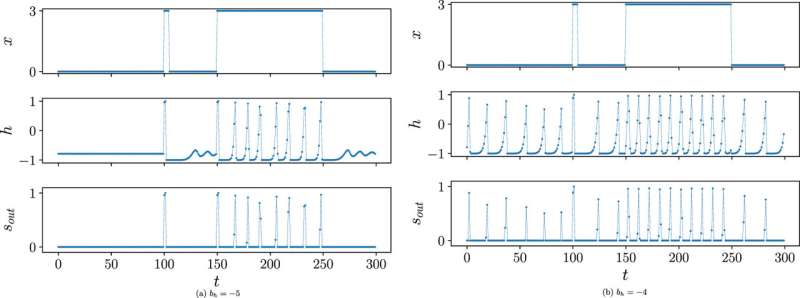
Engineers at the University of Liège have taken a major step forward in the architecture of artificial neural networks by creating a new type of spiking neuron. Called the Spiking Recurrent Cell (SRC), this innovative model combines the simplicity of implementation with the ability to reproduce the dynamics of biological neurons. Add to this the energy efficiency of spiking neurons, and this new model offers exciting new prospects for neuro-inspired artificial intelligence. The work is published in the journal Neuromorphic Computing and Engineering.
Artificial Neural Networks (ANNs) and Spiking Neural Networks (SNNs) are two types of neural networks used in artificial intelligence. However, they differ significantly in their structure, operation and applications.
ANNs are widely used for a variety of machine learning applications (image recognition, speech recognition, games) and are relatively easier to implement. However, they are energy-inefficient and computationally expensive.
SNNs, on the other hand, are used in applications requiring sensitivity to the precise timing of events (robotics, brain-computer interface, sensory processing) and offer a more realistic modeling of biological neural processes. They differ from ANNs in that the mode of communication between neurons is based exclusively on impulses (spikes), thus mimicking the way biological neurons function.
“Their main advantage is their energy efficiency,” explains Florent De Geeter, a research engineer at the Montefiore Institute at the University of Liège.
“When these SNNs are run on specific hardware—known as neuromorphic hardware—their energy consumption becomes extremely low. This characteristic means that such networks can be used in situations where energy efficiency is paramount, such as in embedded systems, which are autonomous computer and electronic systems that perform a precise task within the device in which they are integrated.”
Unlike ANNs, SNNs are difficult to train, and current research is focused on designing training algorithms to enable them to compete with ANNs on complex tasks.
As part of an ambitious project at ULiège, researchers have tried a new approach: by modifying the dynamics of a well-known type of artificial neuron that is easy to train, they have succeeded in mimicking the behavior of biological neurons, giving rise to a new model: the Spiking Recurrent Cell (SRC).
SRC: A bridge between ANNs and SNNs
“The major innovation of this study lies in the design of this Spiking Recurrent Cell (SRC),” explains Damien Ernst, professor at ULiège and co-author of the study, “a neuron model capable of generating spikes autonomously, like biological neurons. Unlike conventional SNN models where spikes are generated artificially, the SRC model allows for a more natural and dynamic emulation of neuronal impulses.”
This new model makes it possible to integrate the sophisticated learning algorithms of ANNs with the energy efficiency of SNNs. In this way, SRCs offer a hybrid solution, combining the advantages of both types of neural network and paving the way for a new generation of SNNs.
Implications and future applications
The potential applications of SRCs are vast. Due to their energy efficiency, SNNs can be used in contexts where energy consumption is critical, such as the on-board systems in autonomous vehicles.
“Furthermore, the ability of the SRC model to simulate various neuronal behaviors by adjusting its internal parameters makes these networks more expressive and closer to biological networks, enabling significant advances in the understanding and reproduction of brain functions,” says Guillaume Drion, director of the Neuromorphic Engineering Laboratory at ULiège and co-author of the study.
The creation and introduction of the SRC represents a significant advance in the field of neural networks, combining the strengths of ANNs and SNNs. This innovation opens new prospects for the development of more efficient and energy-saving intelligent systems.
More information:
Florent De Geeter et al, Spike-based computation using classical recurrent neural networks, Neuromorphic Computing and Engineering (2024). DOI: 10.1088/2634-4386/ad473b
University de Liege
Citation:
A new spiking neuron narrows the gap between biological and artificial neurons (2024, May 29)
retrieved 29 May 2024
from https://techxplore.com/news/2024-05-spiking-neuron-narrows-gap-biological.html
This document is subject to copyright. Apart from any fair dealing for the purpose of private study or research, no
part may be reproduced without the written permission. The content is provided for information purposes only.










